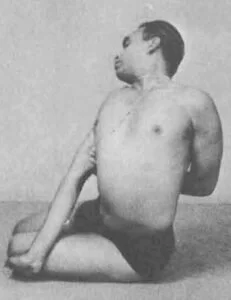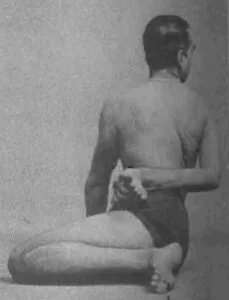 Bharadvajasana (IPA: [bʱɐrɐd̪ʋɑːɟɑːsɐnɐ]; Sanskrit: भरद्वाजासन; IAST: Bharadvājāsana) is an āsana.
Bharadvajasana (IPA: [bʱɐrɐd̪ʋɑːɟɑːsɐnɐ]; Sanskrit: भरद्वाजासन; IAST: Bharadvājāsana) is an āsana.
The asana dedicated to sage Bharadvāja who was one of the Saptarshis (Seven Great Sages Rishi) in the present Manvantara; the others being Atri,
Vashishtha, Vishvamitra, Gautama, Jamadagni, and Kashyapa. Bharadvāja was also the father of Drona who was a master of advanced military arts and the royal
guru to Kauravas, Pandavas and the Devastras., the princes who fought the great war which is the subject of the Mahābhārata.
Bharadvājāsana is a basic seated spinal twist. It has three main variations:
Bharadvājāsana II is the advanced variation requiring high hip mobility in which one leg articulated as in the Padmasana (lotus position), while the other
the leg is articulated as in the Vīrāsana.
Bharadvājāsana I is the basic variation in which the legs articulated as in vīrāsana dropped to one side one foot on the floor and the other’s ankle cradled
in the arch of the foot below.
Bharadvājāsana on the chair is a third variant which is performed sitting sideways on an armless chair, which does not require hip mobility, utilizing the back
seat to provide gentle resistance to the arms, to assist with the twist.
The vinyasa for Bharadvājāsana I begins in dandasana from which,
The legs are bent at the knees, dropping them to the left, bringing the feet to the right hip.
The right foot end top down on the floor and cradling the left ankle within the arch of the right foot.
The torso is rotated 45° to the left.
The right arm is straightened and the hand is inserted under the left knee.
The legs are released, returning to dandasana for a few moments to release the knees.
Repeat on the left side.
Anatomy:-
The main action in Bharadvājāsana is spinal rotation towards the leg which articulated as in the Vīrāsana
During a twist, the torso is rotated right using the action of pair of muscles acting in synergies such as left external oblique and right internal oblique
which work while the right external oblique and left internal oblique are stretched. Thus the ability to perform the twist depends both on the strength of
the obliques and their ability to stretch, which can restrict the rotation. If ujjayi breath technique is employed all the following muscles can be
recruited for spinal twisting motion.
Throughout the spine.
The multifidus.
The rotatores.
The intertransversarii.
The erector spinae muscles consisting of the longissimus, iliocastalis and Spinalis.
The iliocastalis cervicis.
Rotation of the neck is due to rotation in the cervical spine using
The left and right sternocleidomastoid in the sides of the neck.
The left and right spenius in the back of the neck.
The longus colli in the back of the neck.
The scalenes in the back.
The levator scapulae in the back.
Rotation of the torso is due to the thoracic and lumbar spine and using
The inner and outer obliques.
The left and right psoas major.
The quadratus lumborum.
In Bharadvājāsana, a typical practitioner should expect 5° of rotation in the lumbar spine (yellow); 35° in the thoracic spine (indigo) and 50° in the
cervical spine (red). These add up to 90° of spinal rotation between hips and head which may be reached in this twist. However, just trunk rotation has
26 articulation points and if any have a reduced range of motion the others will be forced to over-compensate which is the risk factor contributing to injury
in yoga twists.
Reduced mobility in the hips will necessitate some spinal flexion (leaning forward). In all but the tightest of the hip, this can usually be compensated by
sitting on a supporting wedge which allows a cleaner twisting motion without forwarding flexion. If a wedge cannot compensate then Bharadvājāsana, should be
performed sitting on a chair.
Adjustments:-
To help ground the buttock on the side opposite the twist (e.g. when twisting right the left buttock may cause the spine to move out of alignment). The
adjuster standing on the student’s left side should place the left foot on the top of the student’s left thigh with the inner edge of the foot in the hip
crease and gently apply pressure. As the student exhales moving into the twist the top left thigh should relax away from the adjusting foot. The adjuster can
reach and place fingers on both shoulders to help the student find the correct alignment of the shoulders through moving back and opening the chest.[10]
Cautions:-
For correct spinal alignment, it is necessary that both buttocks be in contact with the floor. If the twisting causes one to tilt onto the buttock on the
tilting side, a folded mat should be placed under the other buttock to allow one to relax with both buttocks on the floor.
If one slouches, the spine is not kept straight and the twist will be far less effective.
Benefits:-

Stretches:
Spine,
Shoulders and
Hips.
Massages the abdominal organs.
Improves digestion.
Relieves:
Lumbago,
Cervicalgia, and
Sciatica.
Reduces stress.
Useful for strengthening the lower back during the second trimester of pregnancy.
Therapeutic for carpal tunnel syndrome
